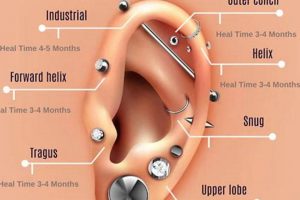The development of the ridged skin patterns on fingers and toes, uniquely identifying each individual, occurs remarkably early in human development. These intricate formations, crucial for grip and tactile sensation, begin to emerge during the fetal stage. The process unfolds gradually over several weeks, culminating in the permanent and unchanging patterns observed throughout life.
The presence of these unique patterns is fundamental to forensic science, providing a reliable method for identification. These friction ridges also enhance the ability to grasp objects securely. The discovery and understanding of their permanence have revolutionized criminal investigations and identification procedures. Notably, the detailed formation of these patterns is influenced by both genetic and environmental factors within the womb.
The timeline for the development of these patterns spans from the early weeks of gestation through the second trimester. Examining the specific stages of fetal development provides a detailed understanding of the biological mechanisms that govern the creation of these unique identifiers.
Understanding the Development Timeline
Gaining a clear understanding of the timing of fingerprint development is essential for various fields, from medicine to forensics. Awareness of this process allows for informed decisions and assessments.
Tip 1: Focus on Gestational Age: The crucial period for fingerprint development spans from approximately 10 to 18 weeks of gestation. Research and studies typically reference gestational age when discussing this process.
Tip 2: Understand the Role of the Basal Layer: Fingerprints are formed within the basal layer of the epidermis. Factors affecting this layer during gestation can influence the development of the patterns.
Tip 3: Consider Genetic and Environmental Influences: While largely genetically determined, the precise details of fingerprint patterns are also subject to minor influences from the intrauterine environment.
Tip 4: Note the Permanence of the Patterns: The patterns established during fetal development remain unchanged throughout an individuals life. This permanence is a cornerstone of their use in identification.
Tip 5: Recognize the Uniqueness: Even identical twins, who share nearly identical genetic material, possess unique fingerprints. This individuality underscores the complexity of the developmental process.
Tip 6: Differentiate from Palmar Creases: While related to hand development, palmar creases are distinct from fingerprints and develop through different mechanisms.
Understanding these key aspects facilitates a more comprehensive appreciation of how and pattern’s develop, and the factors influencing them.
This knowledge provides a foundation for further exploration into the broader field of human development and forensic science.
1. Gestational Period
The gestational period, the time between conception and birth, is intrinsically linked to the question of when these unique identifiers develop. The events occurring within this timeframe dictate the formation, and ultimate permanence, of these patterns.
- Timeline of Ridge Formation
The emergence of these patterns is not instantaneous. It occurs gradually between approximately 10 and 18 weeks of gestation. During this period, the basal layer of the epidermis begins to buckle and fold, creating the distinct ridge patterns that become fingerprints. The precise timing of these developmental stages significantly affects the final configuration.
- Influence of Amniotic Fluid
The intrauterine environment, specifically the composition and pressure of the amniotic fluid, can exert subtle influences on the developing patterns. While genetic factors primarily determine the overall design, minor variations in the amniotic fluid dynamics during the critical period of ridge formation can contribute to the uniqueness of each individual’s fingerprints. This highlights the interplay between genetic predispositions and environmental factors.
- Development of Volar Pads
Preceding the formation of the ridges, volar pads (transient swellings on the fingertips) appear during early gestation. The shape and size of these pads influence the flow of epidermal cells, thereby affecting the ridge patterns. Variations in volar pad morphology contribute to the diversity observed in fingerprint characteristics. Their development is a crucial precursor to permanent fingerprint formation.
- Role of Gene Expression
The expression of specific genes governs the cellular processes involved in skin development. During the gestational period, these genes orchestrate the differentiation and organization of epidermal cells, ultimately shaping the fingerprint patterns. Any disruption in gene expression during this critical window can lead to variations or abnormalities in fingerprint formation, underscoring the genetic component of this developmental process.
In conclusion, the gestational period encompasses a complex series of developmental events that collectively determine when a baby gets fingerprints. The interplay between genetic programming, environmental influences, and precisely timed developmental stages highlights the intricate nature of this fundamental aspect of human individuality.
2. Basal layer formation
The development of fingerprints is inextricably linked to the formation and characteristics of the basal layer of the epidermis. This layer, the innermost layer of the skin, plays a critical role in the genesis of the unique ridge patterns that define individual identity. Understanding the processes within this layer is essential to understanding the developmental timeline of these patterns.
- The Basal Layer as a Template
The basal layer serves as the foundational template upon which fingerprints are formed. Its cellular organization and proliferation patterns directly influence the topography of the overlying epidermal layers. Early in gestation, the basal layer undergoes a process of buckling and folding, creating the primary ridges that will later become the permanent fingerprint pattern. Any disruption to the basal layer during this critical period can alter the final pattern.
- Timing and Differentiation
The timing of basal layer differentiation is crucial. Around the 10th to 18th week of gestation, cells within this layer begin to specialize and organize into the distinct ridge structures. This differentiation process is tightly regulated by gene expression and signaling pathways. Premature or delayed differentiation can lead to atypical fingerprint patterns. The timing of this process directly answers “when does a baby get fingerprints,” pinpointing it to this specific gestational window.
- Impact of Volar Pads
Volar pads, transient swellings on the fingertips during early fetal development, influence the basal layer. The shape and prominence of these pads affect the direction and flow of epidermal cells within the basal layer. This, in turn, impacts the ridge patterns that eventually form. Larger or asymmetrical volar pads can result in more complex or unique fingerprint characteristics. The interaction between volar pads and the basal layer highlights the multifactorial nature of fingerprint development.
- Environmental Sensitivity
The basal layer is susceptible to environmental influences during its development. Factors such as maternal nutrition, exposure to toxins, or even mechanical forces within the womb can affect cellular proliferation and differentiation in the basal layer. These subtle environmental perturbations can contribute to the individual variations observed in fingerprint patterns. The sensitivity of the basal layer underscores the importance of a stable and supportive intrauterine environment for optimal fingerprint development.
The basal layer’s role in fingerprint development highlights the intricate orchestration of biological processes required for the formation of these unique identifiers. The timing of its differentiation, its interaction with volar pads, and its sensitivity to environmental factors all contribute to the unique fingerprint patterns that emerge during gestation, directly connecting basal layer formation to the answer to “when does a baby get fingerprints”.
3. Weeks ten to eighteen
The period spanning from the tenth to the eighteenth week of gestation represents the critical window during which fingerprint development occurs. This timeframe is not arbitrary; it marks the period when the necessary biological processes converge to initiate and establish the permanent epidermal ridge patterns. Prior to week ten, the volar pads, precursors to fingerprints, begin to form. After week eighteen, the basic fingerprint pattern is largely set, with only minor modifications occurring thereafter. Disruptions or variations within this period have the potential to significantly impact the final fingerprint characteristics. For example, abnormal amniotic fluid pressure during this time may influence ridge spacing, leading to unique or atypical patterns. Understanding this precise timeline is essential for interpreting developmental anomalies and potential forensic applications.
The practical significance of identifying this specific developmental period lies in its implications for prenatal diagnostics and forensic science. If, hypothetically, a teratogenic agent were to specifically target fingerprint development, the observable effects would be most pronounced in individuals exposed during this ten-to-eighteen-week window. Furthermore, a precise understanding of the timing of fingerprint formation allows for more accurate age estimation of fetal remains in forensic investigations. Analyzing the degree of ridge development can provide valuable information for determining gestational age, particularly in cases where other indicators are unavailable or unreliable. This knowledge also has implications for understanding the genetic and environmental factors that influence human development.
In summary, the gestational period of weeks ten to eighteen is intrinsically linked to the development of fingerprints. It is the time when the complex interplay of genetics, cellular differentiation, and environmental factors culminates in the formation of these unique identifying markers. Comprehending this timeline not only contributes to a more profound understanding of human development but also provides practical benefits in fields such as forensic science and prenatal medicine. While the precise mechanisms continue to be researched, the importance of this specific timeframe remains undisputed as it is directly related to “when does a baby get fingerprints”.
4. Permanent, unique patterns
The concept of permanent and unique epidermal ridge patterns is central to understanding the timeline of their development. These identifiers, once formed, remain unchanged throughout an individual’s life, providing a reliable basis for identification and forensic analysis. The establishment of these characteristics during fetal development is a crucial event.
- Stability Over Time
The enduring nature of these patterns is a consequence of their deep structural formation within the skin. Unlike surface features that may change due to injury or disease, these ridges are rooted in the dermal layer and are therefore resistant to alteration. This stability ensures the reliability of fingerprint analysis in various contexts, from criminal investigations to biometric identification systems. In cases of superficial skin damage, the original pattern regenerates upon healing, demonstrating its inherent permanence.
- Genetic and Environmental Contributions
The uniqueness of the ridges arises from a complex interplay of genetic predisposition and environmental influences during gestation. While genes provide the blueprint for ridge formation, subtle variations in the intrauterine environment, such as amniotic fluid pressure and fetal movements, contribute to the minute details that differentiate each individual’s fingerprints. Even identical twins, who share nearly identical genetic material, exhibit distinct fingerprint patterns, underscoring the role of non-genetic factors.
- Formation During Gestation
The critical period for establishing these patterns occurs between approximately 10 and 18 weeks of gestation. During this time, the basal layer of the epidermis proliferates and differentiates, forming the ridges that will become permanent. Disruptions or abnormalities during this gestational window can lead to variations in the fingerprint patterns, highlighting the sensitivity of this developmental process. This period directly answers the question of the developmental timeline.
- Forensic Applications
The permanence and uniqueness of these patterns have revolutionized forensic science. Fingerprint analysis is a cornerstone of criminal investigations, providing a reliable method for identifying suspects and linking them to crime scenes. The statistical probability of two individuals having identical fingerprints is astronomically low, making it a powerful tool for establishing identity. The enduring nature of the ridges ensures that fingerprints collected years or even decades after their formation remain valid and informative.
In summary, the permanent and unique nature of epidermal ridge patterns is intrinsically linked to the developmental processes that occur during a specific gestational period. This combination of stability, genetic influence, environmental interaction, and gestational timing underpins the significance of the fingerprint in various scientific and legal applications.
5. Genetic and environmental influences
The development of epidermal ridge patterns, commonly known as fingerprints, is a complex process governed by a combination of genetic predispositions and environmental factors experienced in utero. The interplay of these influences during a specific gestational window determines the unique characteristics of an individual’s fingerprints.
- Gene Expression and Fingerprint Patterning
Specific genes orchestrate the formation of epidermal ridges. These genes regulate cell proliferation, differentiation, and spatial organization within the developing skin. Variations in these genes can affect ridge density, pattern type (arches, loops, whorls), and overall fingerprint morphology. For instance, variations in genes involved in limb development can indirectly influence fingerprint patterns, as the development of the hand and the development of fingerprints are coordinated. A study of families with rare genetic disorders affecting limb development revealed correlated changes in fingerprint patterns, highlighting the link between gene expression and fingerprint morphology. These genetic influences are most impactful during the ten-to-eighteen-week gestational window, correlating directly with when does a baby get fingerprints.
- Amniotic Fluid Dynamics and Ridge Formation
The intrauterine environment, specifically the dynamics of amniotic fluid, exerts subtle influences on fingerprint development. Fetal movements and the physical forces exerted by the amniotic fluid can affect the alignment and spacing of epidermal ridges. Variations in amniotic fluid pressure can lead to minor alterations in the developing pattern, contributing to the uniqueness of each individual’s fingerprints. Studies have shown that reduced fetal movement due to certain medical conditions is associated with less intricate fingerprint patterns. The impact of amniotic fluid dynamics occurs during the critical period of ridge formation, directly influencing when does a baby get fingerprints.
- Maternal Nutrition and Epigenetic Modifications
Maternal nutrition and exposure to certain environmental toxins can induce epigenetic modifications that affect gene expression during fingerprint development. Epigenetic modifications, such as DNA methylation and histone acetylation, can alter the activity of genes involved in ridge formation without changing the underlying DNA sequence. Maternal malnutrition during pregnancy has been linked to altered DNA methylation patterns in offspring, potentially influencing fingerprint characteristics. These epigenetic effects are most pronounced during the period of active fingerprint development, further defining when does a baby get fingerprints.
- Volar Pad Morphology and Pattern Determination
The shape and size of volar pads, transient swellings on the fingertips during early gestation, exert a significant influence on fingerprint patterns. These pads guide the flow of epidermal cells during ridge formation, dictating the overall pattern type (arch, loop, whorl). Genetic factors determine the basic morphology of the volar pads, while environmental influences can subtly modify their shape and size. Variations in volar pad morphology contribute to the wide range of fingerprint patterns observed in the human population. The formation and influence of volar pads is critical to understanding when does a baby get fingerprints as it occurs during the 10-18 week gestational period.
The integration of genetic programming and environmental modulation during the crucial gestational period underscores the complexity of fingerprint development. While genes provide the fundamental blueprint, the subtle nuances introduced by environmental factors ensure the uniqueness of each individual’s epidermal ridge patterns, providing a conclusive answer to the question of when does a baby get fingerprints.
Frequently Asked Questions
This section addresses common inquiries regarding the timeline of epidermal ridge pattern development, commonly referred to as fingerprints.
Question 1: At what point during pregnancy do fingerprints begin to form?
The process initiates between the tenth and eighteenth week of gestation. This period is crucial for the establishment of the primary ridge patterns.
Question 2: What factors influence the uniqueness of these patterns?
Both genetic predispositions and environmental conditions within the uterus contribute to the individualized nature of fingerprints. Subtle variations in amniotic fluid dynamics, as well as minor genetic differences, play a role.
Question 3: Are the fingerprints fully formed at birth?
By the time of birth, the basic fingerprint patterns are fully established. However, minor maturation of the skin may continue postpartum.
Question 4: Can external factors after birth alter fingerprint patterns?
Fingerprints, due to their deep dermal origin, are highly resistant to alteration. Superficial damage to the epidermis will not permanently change the underlying pattern.
Question 5: Do identical twins have the same fingerprints?
While identical twins share nearly identical genetic material, their fingerprints are not identical. Variations in the intrauterine environment lead to unique ridge patterns.
Question 6: Is it possible to determine gestational age based on fingerprint development?
Analyzing the degree of ridge development can provide valuable information for estimating gestational age, particularly in cases involving fetal remains.
Understanding these key aspects facilitates a more comprehensive appreciation of the intricacies and stability of fingerprints.
This knowledge provides a foundation for further exploration into the broader fields of human development and forensic science.
Conclusion
The exploration of when does a baby get fingerprints reveals a precise developmental timeline occurring primarily between the tenth and eighteenth week of gestation. During this period, genetic factors interact with the intrauterine environment to establish the unique, permanent ridge patterns that characterize individual identity. The basal layer of the epidermis undergoes differentiation, influenced by volar pads and amniotic fluid dynamics, culminating in the formation of these identifiers. This specific gestational window is critical, as disruptions during this time can affect the ultimate fingerprint pattern.
The knowledge gained from understanding when does a baby get fingerprints holds significant implications for forensic science, prenatal diagnostics, and our broader understanding of human development. Continued research into the precise genetic and environmental mechanisms governing fingerprint formation promises to further refine our ability to utilize these unique markers in diverse applications, solidifying their importance in both scientific and legal contexts.







